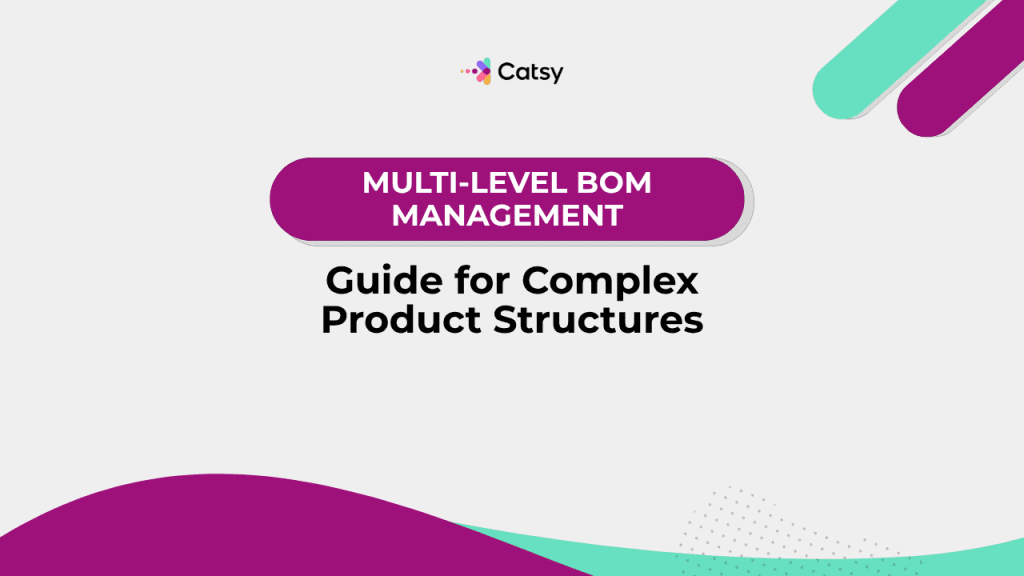Multi-level BOM (Bill of Materials): Management with PIM
What You’ll Learn:
What multi-level BOMs are and why they’re essential for complex product manufacturing
Common challenges teams face managing multi-level BOMs manually or across siloed systems
How PIM systems improve BOM accuracy, visibility, and change management
Best practices and advanced features for scaling BOM workflows using PIM

Understanding Multi-Level BOMs: Beyond Simple Parts Lists
What Makes a BOM “Multi-Level”?
A multi-level BOM is essentially a hierarchical structure that breaks down a finished product into its constituent parts, sub-assemblies, and raw materials across multiple organizational levels. Think of it like a family tree for your product—each level represents a different generation of components that combine to create the final result.
Unlike single-level BOMs that simply list all components in a flat structure, multi-level BOMs capture the actual assembly relationships. They show not just what parts you need, but how those parts fit together, which components depend on others, and how changes at one level impact everything else.
The Anatomy of Multi-Level BOM Structure
At the top level (Level 0), you have your finished product. Level 1 consists of major sub-assemblies or primary components. Level 2 breaks these down further into smaller sub-assemblies and parts. This hierarchy continues down to the most basic components—screws, resistors, raw materials—that can’t be broken down further.
For example, consider a laptop computer:
- Level 0: Complete laptop
- Level 1: Display assembly, keyboard assembly, motherboard assembly, battery pack
- Level 2: LCD panel, display frame, keyboard keys, circuit board, processor
- Level 3: Individual resistors, capacitors, screws, cables
In this Article
The Challenge of Multi-Level BOM Management
Complexity Amplification
Managing multi-level BOMs isn’t just complicated—it’s exponentially complex. Each additional level multiplies the number of relationships you need to track. A change to a single component at Level 3 might affect multiple sub-assemblies at Level 2, which in turn impacts several major assemblies at Level 1.
Common Pain Points
Manufacturing teams frequently struggle with version control nightmares where different departments work with outdated BOM information. Engineering changes cascade through multiple levels without proper impact analysis, leading to production delays and cost overruns. Procurement teams order incorrect quantities because they can’t see the true demand across all product variations.
Data silos create another major headache. Engineering might use PLM systems, manufacturing relies on ERP, and product management works in specialized databases. When these systems don’t communicate effectively, multi-level BOMs become fragmented puzzles with missing pieces.
A major automotive manufacturer discovered that poor multi-level BOM management was costing them $2.3 million annually in excess inventory alone. Components ordered for discontinued vehicle models sat in warehouses because the BOM hierarchy didn't clearly show which parts were shared across multiple product lines.
Enter PIM: Your Multi-Level BOM Command Center
Product Information Management as the Solution
PIM systems excel at managing complex, hierarchical product data—exactly what multi-level BOMs require. Unlike traditional databases that struggle with nested relationships, PIM platforms are designed to handle the intricate web of dependencies that characterize modern products.
Core PIM Capabilities for BOM Management
A robust PIM system provides centralized data governance, ensuring everyone works with the same, up-to-date BOM information. It maintains complete audit trails showing who changed what and when, crucial for regulatory compliance and quality control.
Advanced PIM platforms offer sophisticated relationship mapping, visualizing how components connect across all BOM levels. They can automatically calculate rolled-up costs, lead times, and other critical metrics by aggregating data from multiple hierarchy levels.
Hierarchical Data Visualization
Modern PIM systems transform complex multi-level BOMs into intuitive visual representations. Interactive tree structures let you expand and collapse different levels, while dependency maps show how components relate across the entire product structure. These visualizations make it easy to spot potential issues and understand impact patterns.
Make Catsy DAM and PIM Software an Extension of Your Team
Book a Free DemoBest Practices for Multi-Level BOM Management with PIM
Establish Clear Hierarchy Standards
Consistent naming conventions and numbering schemes are essential. Develop standardized part number formats that encode level information, making it easy to understand a component’s position in the hierarchy at a glance. Define clear rules for when to create new BOM levels versus combining components into existing ones.
Implement Robust Change Management
Every BOM modification should trigger an automated impact analysis showing which other components, assemblies, and products are affected. Establish approval workflows that route changes through appropriate stakeholders based on the scope of impact. Use effectivity dates to control when changes take effect, allowing for planned transitions.
Leverage Automation Intelligently
Configure automated alerts when component specifications change, costs exceed thresholds, or availability issues arise. Set up rules to automatically update quantities when parent assemblies change. Use machine learning capabilities to identify potential optimization opportunities, such as standardizing similar components across multiple products.
Pro Tip: Start with your most complex products when implementing PIM-based BOM management. The benefits become immediately apparent, building organizational support for broader adoption.
Data Quality and Validation
Implement validation rules that prevent common errors like circular references (where Component A requires Component B, which requires Component A). Establish data quality metrics and regular audits to maintain BOM accuracy. Use automated checks to ensure component availability, cost accuracy, and specification consistency.
Advanced PIM Features for Complex BOM Scenarios
Variant Management
Modern products often exist in multiple configurations—different colors, sizes, or feature sets. PIM systems excel at managing these product variants while maintaining clear relationships to master BOMs. You can define base configurations and specify which components vary across different product options.
Effectivity and Revision Control
PIM platforms provide sophisticated revision control, tracking every change to multi-level BOMs over time. Effectivity dating ensures the right BOM version is used for production runs, while maintaining historical records for warranty and compliance purposes.
Cross-Product Analysis
Advanced PIM systems can analyze component usage across your entire product portfolio, identifying standardization opportunities and supplier consolidation possibilities. This capability becomes invaluable when managing families of related products with overlapping BOM structures.
Integration Strategies: PIM and Your Existing Systems
ERP Integration
Your PIM system should seamlessly share BOM data with ERP systems for production planning and procurement. Real-time synchronization ensures manufacturing teams always work with current information, while ERP systems can feed back actual usage data to refine BOM accuracy.
PLM Connectivity
Product Lifecycle Management systems generate the engineering BOMs that PIM systems then optimize for manufacturing and procurement. Establishing smooth data flows between these systems eliminates manual re-entry and reduces errors.
Quality Management Systems
Multi-level BOMs play crucial roles in quality control and regulatory compliance. PIM systems should integrate with quality management platforms to ensure traceability and support recall procedures when necessary.
Measuring Success: KPIs for Multi-Level BOM Management
Accuracy Metrics
Track BOM accuracy rates across different product lines and complexity levels. Monitor the frequency of emergency engineering changes, which often indicate poor initial BOM quality. Measure how quickly teams can identify and correct BOM errors.
Efficiency Indicators
Calculate the time required to create new multi-level BOMs or modify existing ones. Track how long it takes to assess the impact of component changes across multiple BOM levels. Monitor the reduction in duplicate or near-duplicate components across your product portfolio.
Cost Impact
Measure inventory optimization achieved through better BOM management. Track procurement savings from improved component standardization. Calculate the reduction in product development time achieved through BOM reuse and standardization.
Success Story: A consumer electronics company reduced their average product development time by 23% after implementing PIM-based multi-level BOM management. The key was eliminating redundant component evaluations through better visibility into existing BOM structures.
Future Trends in Multi-Level BOM Management
AI-Powered Optimization
Machine learning algorithms are beginning to suggest BOM optimizations, identifying cost reduction opportunities and design improvements by analyzing patterns across multiple products. These systems can recommend component substitutions, highlight over-engineered assemblies, and suggest standardization opportunities.
Real-Time Collaboration
Cloud-based PIM platforms enable real-time collaboration on multi-level BOMs, allowing global teams to work together seamlessly. Integration with collaboration tools means stakeholders can discuss changes in context, reducing miscommunication and speeding decision-making.
Sustainability Integration
Environmental considerations are becoming integral to BOM management. Modern PIM systems track sustainability metrics at the component level, rolling up environmental impact calculations across multi-level structures to support green product development initiatives.
Key Takeaways
Multi-level BOMs represent the nervous system of modern manufacturing—complex, critical, and requiring careful management to function effectively. While the challenges of managing hierarchical product structures are real and significant, PIM systems provide the tools and capabilities needed to transform chaos into clarity.
The key to success lies in treating multi-level BOM management as a strategic capability rather than a necessary evil. Organizations that invest in robust PIM platforms and establish clear governance processes find themselves with competitive advantages: faster product development, reduced costs, improved quality, and greater agility in responding to market demands.
Remember, implementing effective multi-level BOM management with PIM isn’t just about technology—it’s about creating a foundation for sustainable growth and innovation. The complexity of modern products will only increase, making sophisticated BOM management capabilities not just helpful, but essential for long-term success.
Start with your most challenging products, establish clear standards and processes, and leverage the full capabilities of modern PIM platforms. Your future self—and your
Want more tips, tutorials, and insights on product content and e-commerce operations?
Stay connected. We post regularly to help brands like yours scale smarter.
Are You Ready To streamline your product content management?

Frequently Asked Questions
The optimal depth depends on your product complexity and business needs. Most manufacturers find 4-6 levels sufficient, but some complex products like aircraft or automobiles may require 8-10 levels. The key is finding the right balance between detail and manageability. Each level should represent a meaningful assembly or sub-assembly that makes sense from manufacturing, procurement, or design perspectives. Avoid creating levels just for the sake of organization—each level should add value to your process.
Yes, enterprise-grade PIM systems are designed to scale to very large BOMs. However, performance depends on system architecture, data structure optimization, and hardware resources. The key is implementing proper indexing, caching strategies, and potentially partitioning data across multiple databases. Many large manufacturers successfully manage BOMs with hundreds of thousands or even millions of components using modern PIM platforms.
This is where PIM systems really shine. Create master component records that can be referenced by multiple BOMs, rather than duplicating component data. Use component libraries and standardization programs to maximize reuse. Implement clear governance around when to create new components versus reusing existing ones. Many PIM systems offer “where-used” functionality that shows all products using a specific component, making impact analysis much easier.
Engineering BOMs (EBOMs) reflect the product design and show how engineers intend the product to be assembled. Manufacturing BOMs (MBOMs) are optimized for actual production processes and may group components differently for efficiency. A PIM system can maintain both views of the same product, showing relationships between EBOM and MBOM structures. This dual-view capability helps bridge the gap between design intent and manufacturing reality.
Implement change management workflows that automatically identify all affected BOM levels and components. Use impact analysis tools to visualize the ripple effects of proposed changes. Establish approval processes that route changes through appropriate stakeholders based on scope and impact. Many PIM systems offer simulation capabilities that let you model changes before implementing them, helping you understand consequences across the entire multi-level structure.
Training should be role-based and practical. Engineers need to understand how their design decisions create BOM structures. Manufacturing teams need training on how to interpret and use multi-level BOMs for production planning. Procurement teams should learn how to analyze component usage across multiple BOM levels for strategic sourcing. Plan for 2-3 days of initial training followed by ongoing coaching and advanced workshops. The investment in training pays dividends in system adoption and effectiveness.
Implement automated validation rules that check for common errors like circular references, missing components, or incorrect quantities. Establish data governance processes with clear ownership and accountability. Use regular audits and quality metrics to monitor BOM accuracy over time. Consider implementing approval workflows for BOM changes and require documentation of change rationales. Many PIM systems offer data quality dashboards that highlight potential issues for proactive resolution.
Subscribe For More Content
Sign up for monthly tips on how to drive revenue with product content.




